1. INTRODUCTION
Licorice is the root of Glycyrrhiza uralensis Fisch or Glycyrrhizae inflata L. or Glycyrrhiziae glabra L. It is a familiar medicinal herb in traditional medicine widely used today for its numerous beneficial effects on blood circulation, detoxification, phlegm relief, digestion, and harmonizing the effects of other medicines [1]. In addition, this medicinal herb has been proven to have some valuable biological activities such as antioxidant, anti-inflammatory, antifungal, antiviral, and so on [2]. Moreover, several phytochemical studies were conducted leading to the isolation and identification of more and more chemical compounds such as saponins (glycyrrhizic acid, 18β-glycyrrhetinic acid), and flavonoids (liquiritin, isoliquiritin, liquiritigenin, isoliquiritigenin) [3].
There were 2 different forms of licorice used in Vietnamese traditional medicine which were Sinh Cam thao (raw licorice, RL) and Chich Cam thao (honey-fried licorice, HFL). In traditional medicine, material processing was vital to create new and enhanced therapeutic effects, change herbal medicine’s taste, and reduce or eliminate the drug’s adverse reactions. HFL, which was prepared according to the Yin-Yang Theory and Five Elements Theory, had the potential to enhance the effects on the Spleen and Stomach organs, tonify Qi, and improve blood circulation [4].
HFL was processed by fire technique that used heat with excipient honeyaccording to the guidance of Circular No 30/2017/TT-BYT of the Vietnamese Ministry of Health on “Directions guide to processing methods of traditional ingredients” [5]. Exposure to heat during frying was one of the reasons that can affect the marker compounds in licorice, especially glycyrrhizic acid, thus reducing the therapeutic effects of this herbal drug. Therefore, our study aims to investigate the process conditions to the content of glycyrrhizic acid in licorice, and then propose the optimal roasting process for Chich Cam thao.
2. Materials and methods
Medicinal materials: Raw licorice (Radix et Rhizoma Glycyrrhizae) was provided by Khai Ha Pharmaceutical and Medical Supplies Trading Joint Stock Company and met the quality standards of Vietnamese Pharmacopoeia V. A portion of the slice medicinal herb was ground and sieved through a 355-micrometer sieve to obtain fine powder for the quantitation process.
Excipient: honey (whose moisture content was 5.5%, medicinal use).
Chemical materials: Ethanol, acetonitrile, phosphoric acid (HPLC-grade, Merck, Darmstadt, Germany), and ammonium glycyrrhizate reference standard (75.2%, Code G0460000, EP).
Equipment: High-performance liquid chromatography system C18 column (Agilent – 1220, Agilent Technologies, Santa Clara, CA, USA).
200 g of honey was dissolved with the equivalent weight of boiling water. The solution was then mixed well with 1 kg licorice and soaked for 1–2 hours. Finally, the mixture was fried with a small fire and stirred until the medicinal herb turned dark yellow at the surface, brown at the edge, and did not stick to the hand when touched [5].
The frying processing conditions were investigated by selecting the factors and studying them independently. When one factor was being investigated, the remaining were fixed at a level according to Circular 30/2017/TT-BYT. The sample size for each experiment was 100 g of licorice.
The investigated factors in the frying processing method for HFL included: the frying temperature, honey soaking time, ratio of honey to licorice, and ratio of water tohoney. These experiments were conducted according to Table 1.
During the frying process, the temperature was maintained by controlling the temperature of the electric stove and measured using a specialized thermometer.
All samples were evaluated the sensory, the processing efficiency, the processing time, and the content of glycyrrhizic acid. The processing efficiency of HFL was calculated by the following formula:
when:
m1: Mass of HFL (g) h1: Moisture content of HFL (%)
m0: Mass of RL (g) h0: Moisture content of RL (%)
m2: Mass of honey (g) h2: Moisture content of honey (%)
The content of glycyrrhizic acid in RL and HFL samples were determined according to the guidance of Vietnamese Pharmacopoeia V with small modification [6].
Sample solution: Accurately weight about 0.2 g of the fine powder of licorice/HFL to a 250-mL Erlenmeyer flask, add precisely 100 mL of ethanol 70% (v/v), seal tightly, and weight. Sonicate for 30 minutes, let cool, weight again, make up the lost weight with ethanol 70%, shake well, filter, and take the subsequent filtrate to obtain the sample solution.
Standard solution: 0.2 mg/mL of ammonium glycyrrhizate solution in ethanol 70%.
Chromatographic conditions:
Column: C18 column (150×4.6 mm; 5.0 μm)
Mobile phase: Acetonitrile – Phosphoric acid 0.05% (38:62)
Injection volume: 10 μL
Flow rate: 0.9 mL/min
Detector: 254 nm
The sample and standard solutions were analyzed. The content of glycyrrhizic acid in licorice/HFL was calculated by the following formula:
where:
ST: Peak area of sample solution
SC: Peak area of standard solution
CC: Concentration of standard solution (mg/mL)
α: Purity of reference standard (%)
m: Mass of the sample (g)
H: Humidity of sample (%)
Each sample was determined the content of glycyrrhizic acid six (6) times. The content of glycyrrhizic acid between RL and each of the HFL sample were presented as Mean±SD and statistically compared by t-tests in Excel 2016. The difference between groups was considered statistically significant at a p-value < 0.05.
3. RESULTS
After processing, all 5 samples of HFL (after soaking 1 hour) under the different frying temperature conditions had a darker yellow color compared to licorice. In addition, they had a brown outer edge and a characteristic sweet taste (Fig. 1).
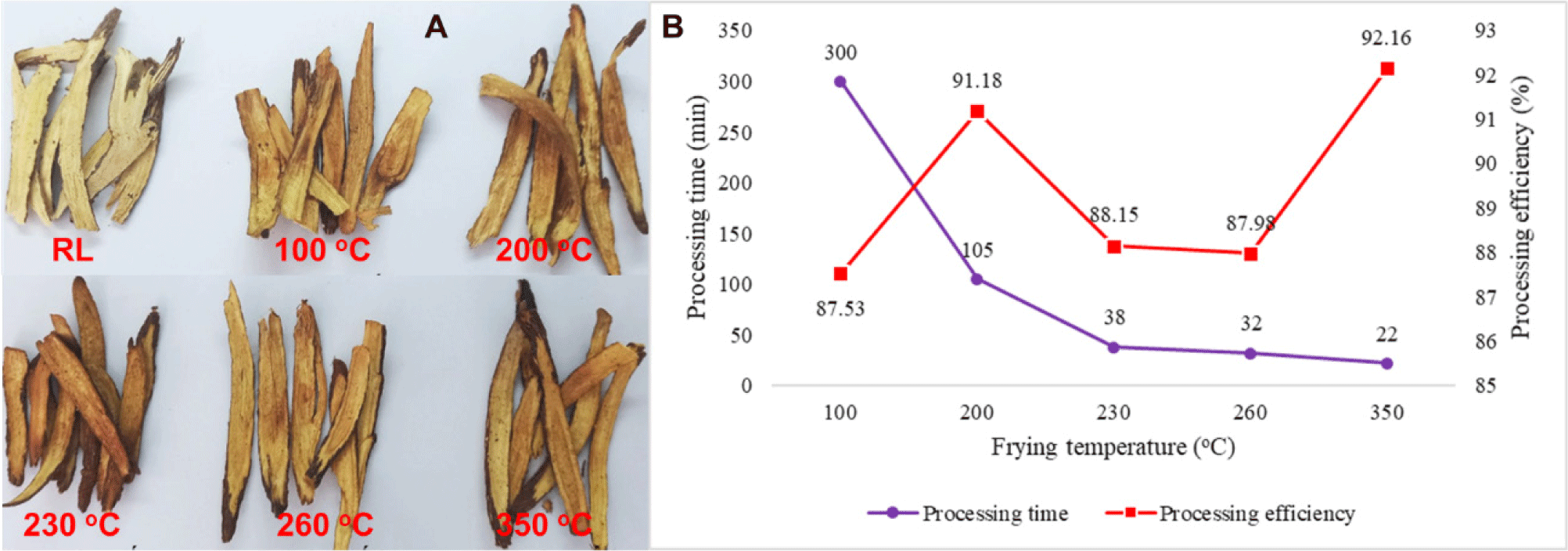
The processing time varied inversely with the frying temperature. As the frying temperature increased, the processing time was shorter and stabilized at temperatures above 230°C. The processing of HFL was more than 85% and was less affected by the frying temperature.
The content of glycyrrhizic acid in RL and HFL samples was shown in Table 2 and Fig. 2.
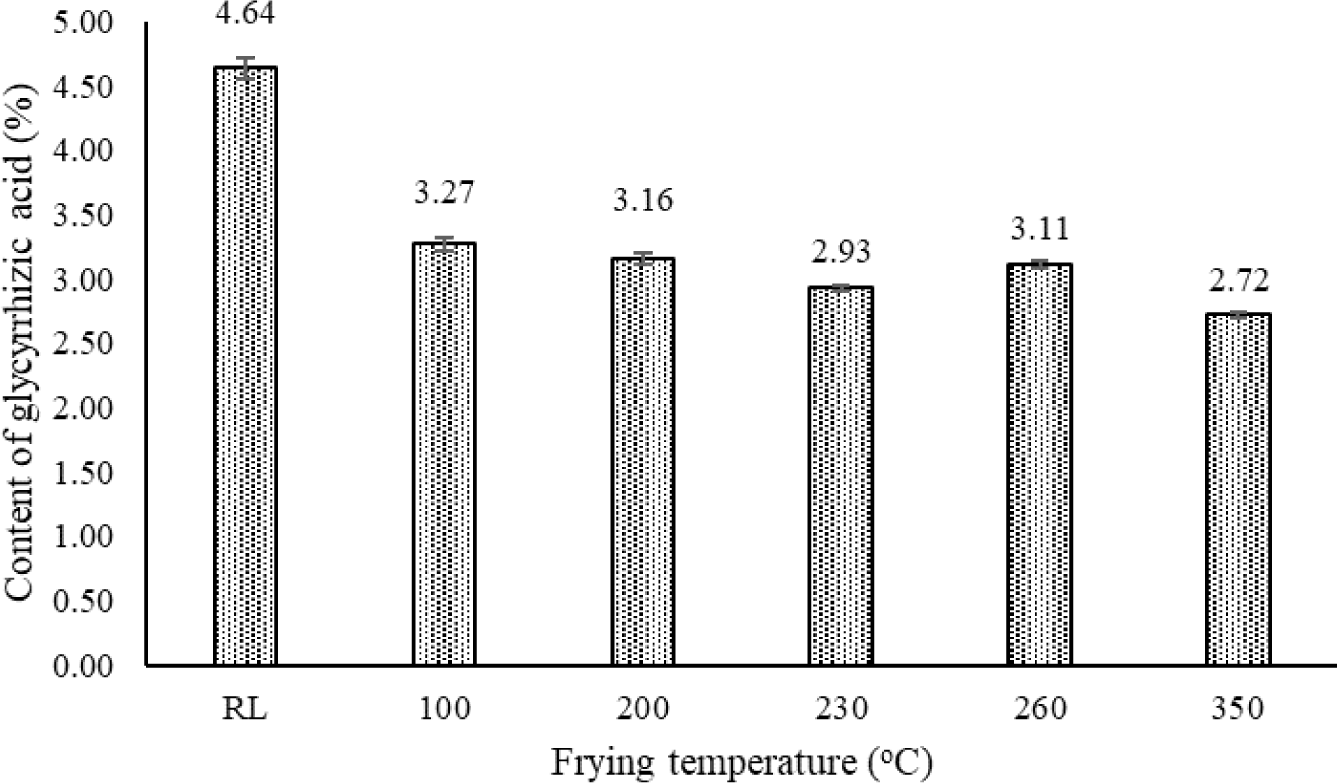
The frying temperature affected strongly the content of glycyrrhizic acid in HFL. The sample fried at 100°C had the least degradation of glycyrrhizic acid (3.27±0.05%; reduced 29% compared to RL), while this marker compound was strongly decomposed when frying at 350°C (2.72±0.02%; a 41% reduction compared to RL). Statistical evaluation using a t-test for the results of the content of glycyrrhizic acid of HFL samples were different significantly compared to raw licorice and different from each other (p<0.05) (Table 3).
| RL | |||||
| 5.29E-12 | 100°C | ||||
| 1.18E-12 | 1.58E-03 | 200°C | |||
| 1.44E-13 | 3.18E-08 | 1.46E-07 | 230°C | ||
| 5.51E-13 | 5.16E-05 | 0.03 | 2.27E-07 | 260°C | |
| 4.37E-14 | 2.82E-10 | 2.53E-10 | 1.82E-08 | 1.17E-10 | 350°C |
The marker compound in licorice, glycyrrhizic acid, was less degraded when processed with honey at 100°C and 200°C (reduced by 29% and 32% compared to RL, respectively). However, this processing method took longer time (processing time >60 minutes). In contrast, HFL which was roasted at 350°C had a shorter processing time (22 minutes) but higher degradation of active ingredient (reduced 41% compared to RL). At a frying temperature of 260°C, glycyrrhizic acid in HFL was less degraded (a 33% reduction), and the processing time was relatively fast (32 minutes). Therefore, a frying temperature of 260°C was selected.
All of the HFL samples (fried at 260°C with different soaking times) met the sensory requirements according to Circular 30/2017/TT-BYT. The honey soaking time had little effect on the processing time and efficiency of HFL. The roasting process was fast (processing time<60 minutes) and the efficiency was more than 85% (Fig. 3).
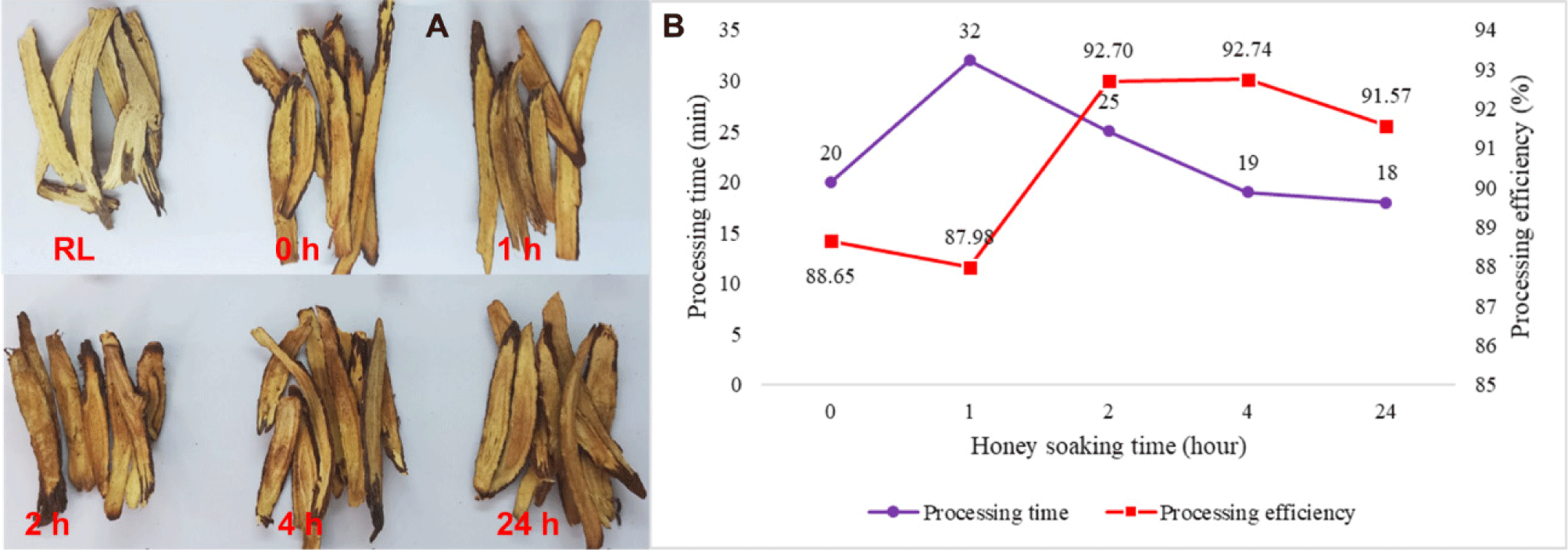
The content of glycyrrhizic acid in RL and HFL samples were performed in Table 4 and Fig. 4.
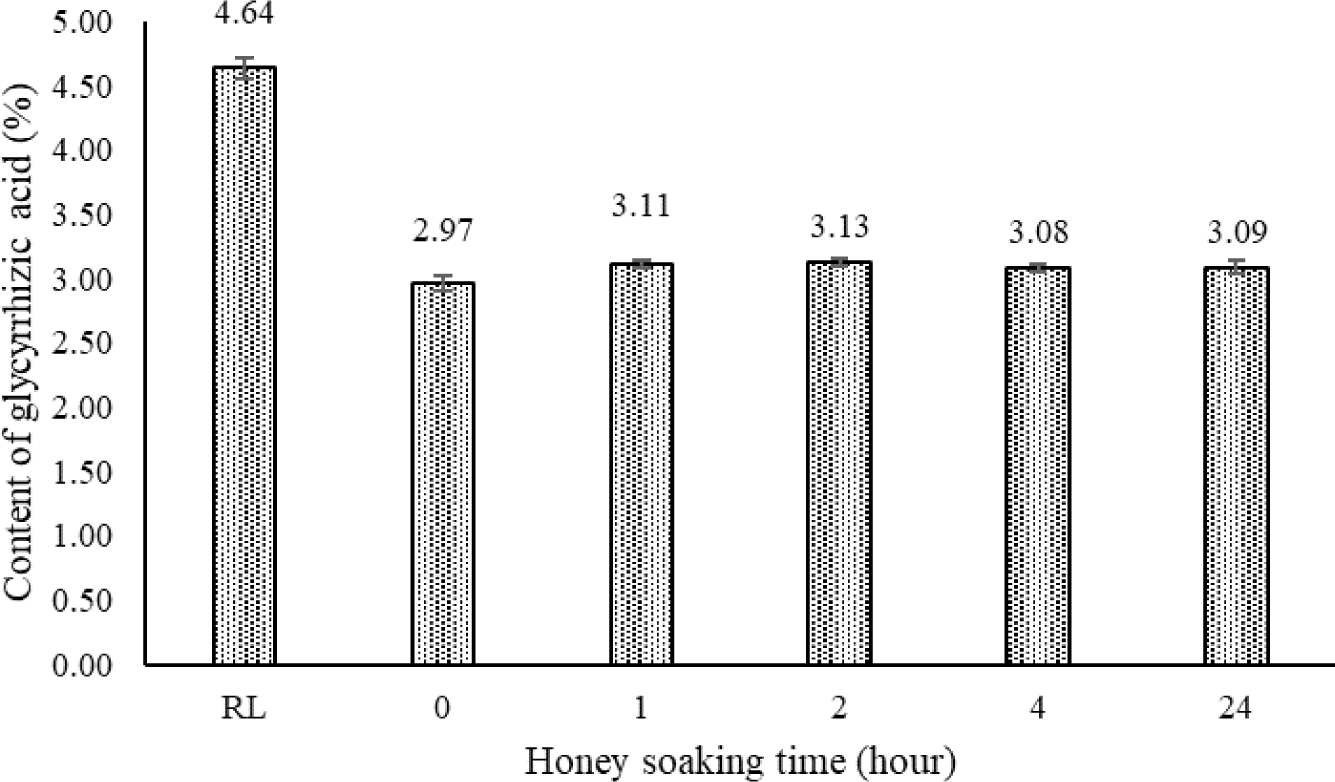
There was little difference in the degradation of glycyrrhizic acid among HFL samples processed with different honey soaking times. The sample without soaking had the lowest content of glycyrrhizic acid (2.97±0.06%; reduced 36% compared to RL), while the sample processed after 2 hours of soaking had the least degradation of active ingredient (3.13±0.03%; reduced 33%). Statistical analysis using a t-test showed that the content of glycyrrhizic acid in different HFL samples was significant compared to raw licorice (p<0.05). The content of glycyrrhizic acid in processed Licorice samples processed after 1, 2, and 24 hours of soaking was not significantly different (p>0.05). Additionally, the content of glycyrrhizic acid in the sample processed without soaking was similar to that of the sample processed after 4 hours of soaking (p=0.16) (Table 5).
| RL | |||||
| 1.33E-12 | 0 h | ||||
| 5.51E-13 | 3.39E-04 | 1 h | |||
| 5.68E-13 | 1.13E-04 | 0.27 | 2 h | ||
| 5.28E-13 | 1.78E-03 | 0.16 | 0.02 | 4 h | |
| 1.43E-12 | 2.76E-03 | 0.46 | 0.14 | 0.72 | 24 h |
HFL without soaking saved time in the processing of medicinal herbs. However, the content of glycyrrhizic acid in the herbal medicine was significantly reduced (reduced 36% compared to RL). The licorice root extract processed after 2 hours of soaking had the highest content of glycyrrhizic acid, but there was no significant difference between the sample processed after soaking for 1 hour. Therefore, the honey soaking time of 1 hour was selected.
Similarly, all 5 samples of HFL under the different ratios of honey to licorice conditions (fried at 260°C after soaking for 1 hour) had a darker yellow color, a brown outer edge, and a characteristic sweet taste compared to RL. Overall, the processing of HFL with different ratios of honey was fast (<60 minutes) and the efficiency was more than 85%. The processing efficiency of the HFL sample with a ratio of honey to licorice of 1:2 was the lowest (86.56%) while requiring the longest processing time (58 minutes) (Fig. 5).
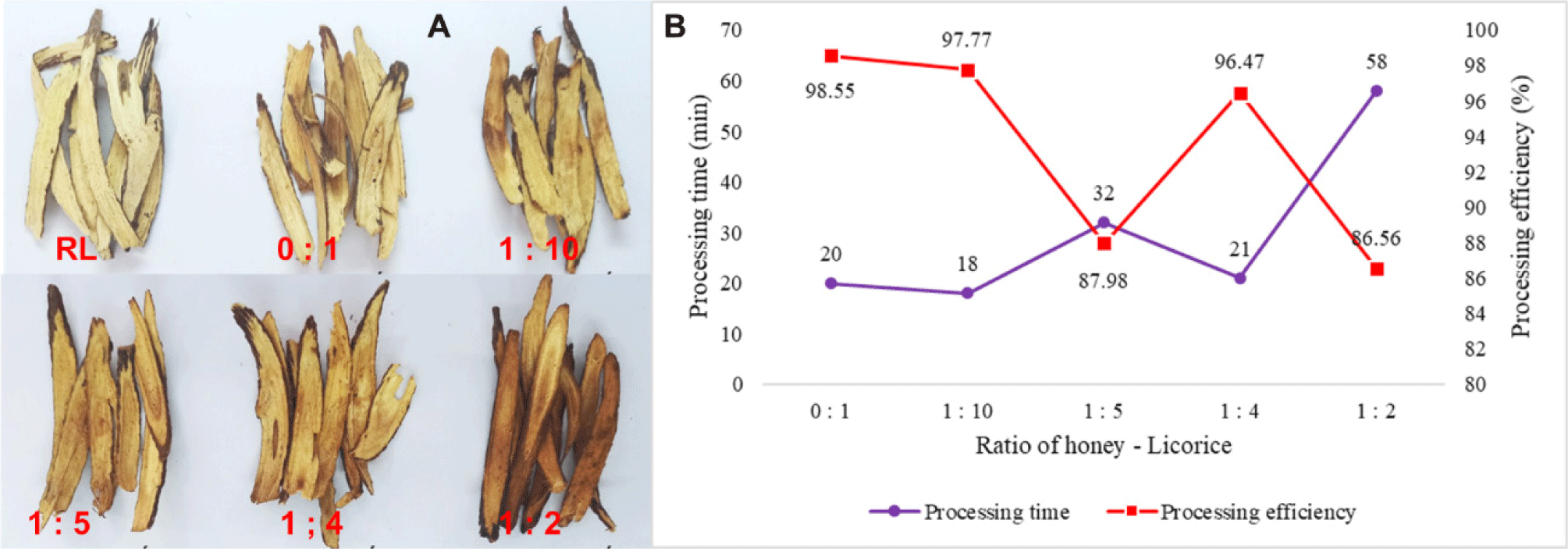
The amount of honey has a significant impact on the degradation of glycyrrhizic acid in HFL (Fig. 6). Statistical analysis using a t-test shows that the content of glycyrrhizic acid in different HFL samples was significant compared to RL (p<0.05) (Table 6). The content of glycyrrhizic acid in processed samples without honey decreased by 25% compared to RL. When honey was present, this marker component was less significantly degraded (3.90±0.04%; reduced 16%). However, as the honey ratio increased in the processing, glycyrrhizic acid was more decomposed, with the lowest content in the sample processed with a ratio of honey to licorice of 1:2 (2.54±0.02%; reduced 45% compared to RL). The HFL sample processed with a ratio of honey to licorice of 1:10 had a short processing time, high processing efficiency, and the least degradation of glycyrrhizic acid. Therefore, a ratio of honey to licorice of 1:10 was chosen (Table 7).
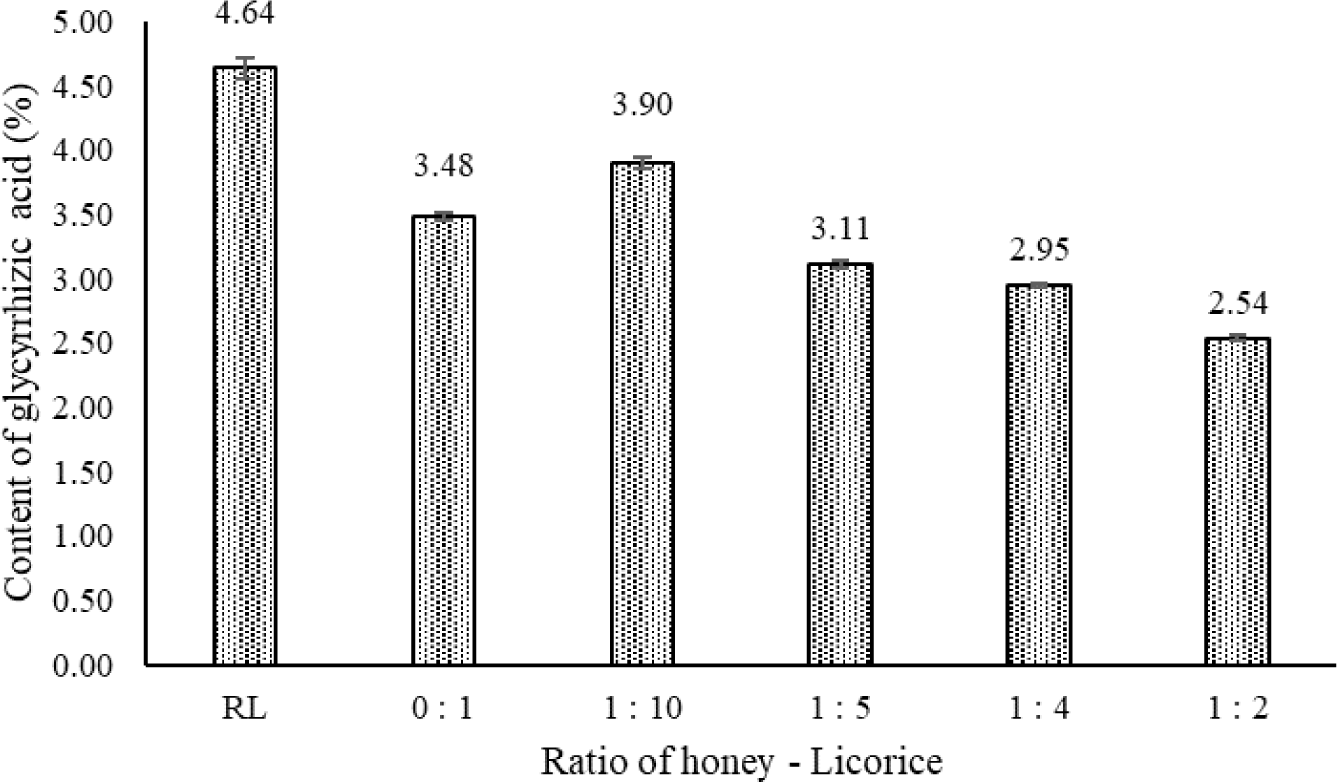
| RL | |||||
| 1.15E-11 | 0:1 | ||||
| 1.53E-09 | 5.00E-09 | 1:10 | |||
| 5.51E-13 | 2.03E-09 | 4.98E-12 | 1:5 | ||
| 1.63E-13 | 2.68E-11 | 4.43E-13 | 8.89E-07 | 1:4 | |
| 1.76E-14 | 7.10E-14 | 1.06E-14 | 2.51E-12 | 1.40E-11 | 1:2 |
All of the HFL samples (fried at 260°C after soaking for 1 hour with honey (ratio of 1:10) met the sensory requirements according to Circular 30/2017/TT-BYT. Overall, the processing of HFL with different ratios of water tohoney was fast (<60 minutes) and the efficiency was more than 95%. The processing efficiency of the HFL sample tended to increase as the ratio of diluted distilled water to honey increased (Fig. 7).
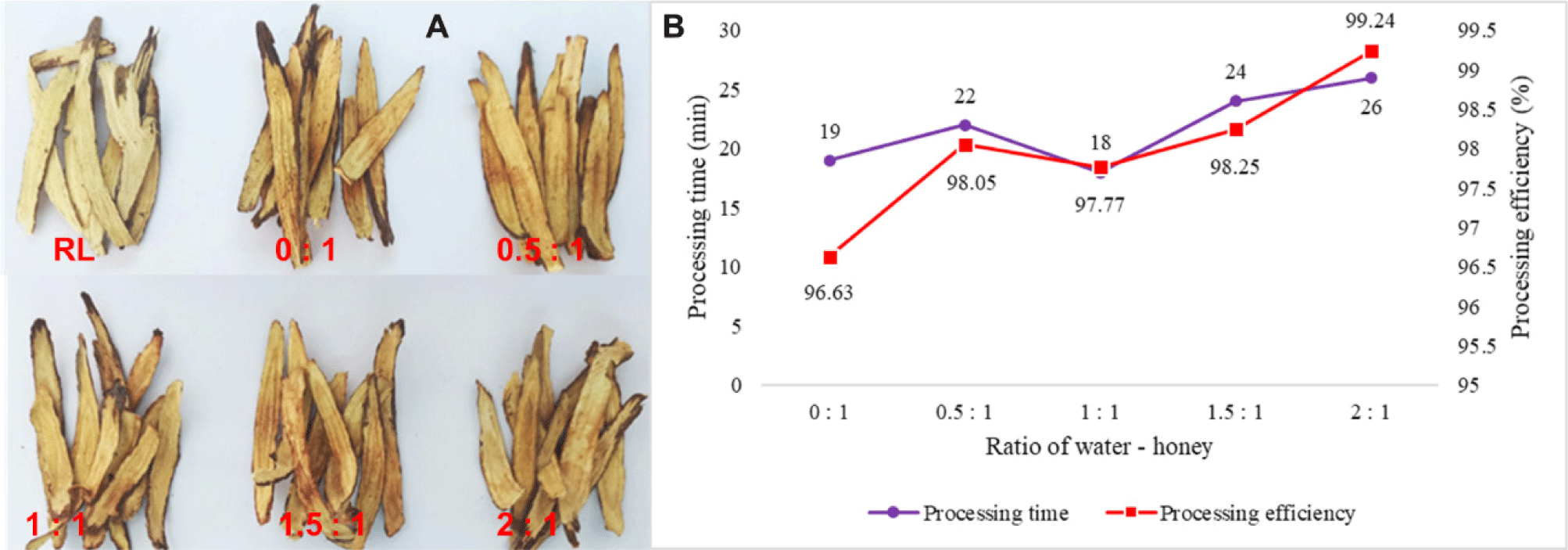
The ratio of water in the processing had an impact on the degradation of glycyrrhizic acid in HFL. Statistical analysis using a t-test shows that the content of glycyrrhizic acid in different HFL samples is significant compared to raw licorice (p<0.05) (Table 8). The content of glycyrrhizic acid in the fried sample processed with a distilled water to honey ratio of 1.5:1 was the lowest, with a reduction of 29% compared to RL. Meanwhile, the HFL processed with a distilled water to honey ratio of 1:1 had the highest content of glycyrrhizic acid (3.90±0.04%; reduced 16%) (Table 9). Therefore, the ratio of water to honey of 1:1 was selected (Fig. 8).
| RL | |||||
| 2.87E-10 | 0:1 | ||||
| 4.90E-12 | 2.28E-08 | 0.5:1 | |||
| 1.53E-09 | 1.56E-04 | 5.55E-10 | 1:1 | ||
| 3.22E-12 | 5.41E-09 | 7.80E-03 | 2.10E-10 | 1.5:1 | |
| 1.28E-11 | 3.04E-07 | 0.02 | 4.88E-09 | 2.19E-04 | 2:1 |
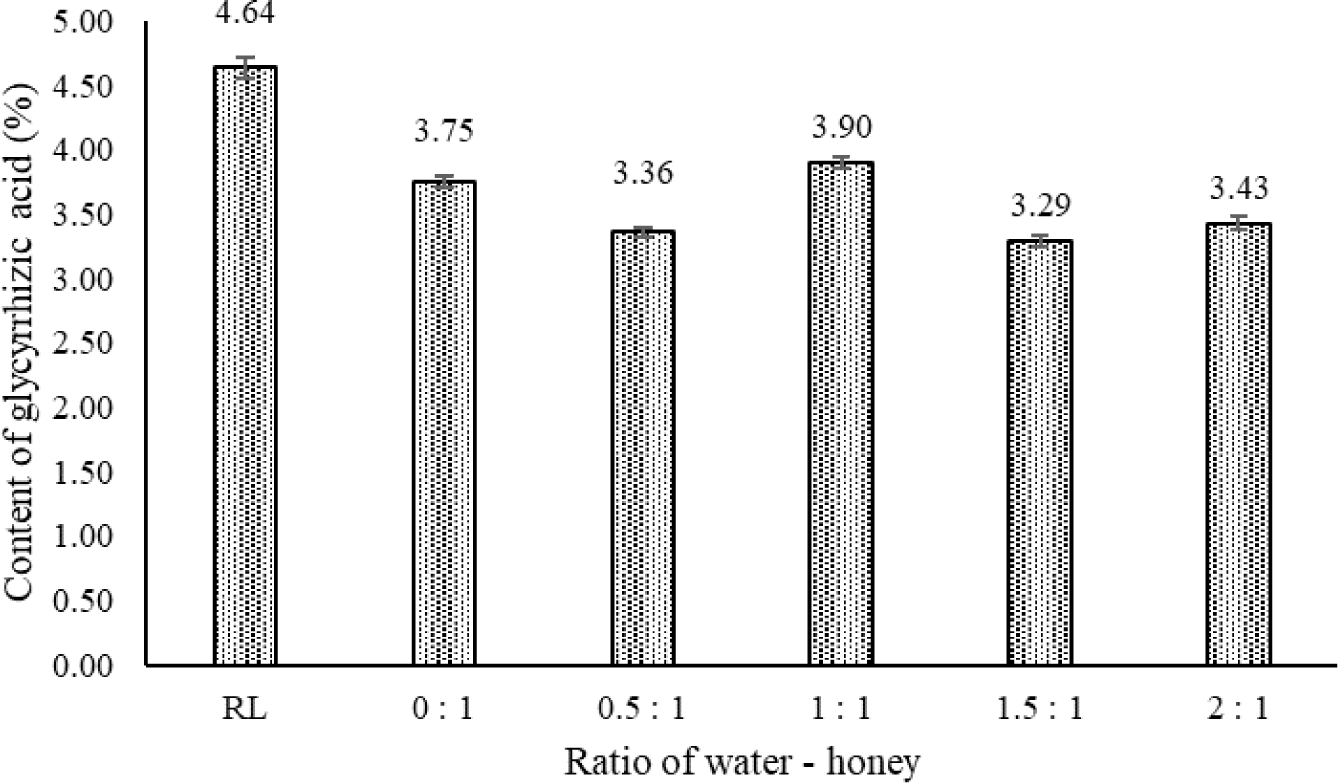
4. DISCUSSION
Frying temperature is one of the factors that directly affect the changes in the composition and quantity of active plant compounds in medicinal herbs during processing. Under the influence of temperature, many chemical compounds undergo structural changes or are degraded to other products. Glycyrrhizic acid was a chemical compound in icorice with many biological effects, such as antibacterial, anti-inflammatory, antiviral, antioxidant, anti-cough, expectorant, detoxifying, etc. [7]–[9]. Raw licorice has a high content of glycyrrhizic acid; therefore, it possesses the function of tonifying the Spleen organ, regulating Qi, moistening Lung, relieving toxicity, promoting digestion, clearing heat, and detoxifying.
The processing of HFL significantly reduced the content of glycyrrhizic acid. A study by Ota et al. in 2018 showed that glycyrrhizic acid was degraded into glycyrrhetinic 3-O-glucuronide and glycyrrhetic acid during the processing of HFL. When increasing the temperature and duration of the processing, glycyrrhizic acid was completely degraded, and glycyrrhetic acid 3-O-glucuronide went on decomposing into 18β-glycyrrhetinic acid, thereby reducing the function of promoting digestion and detoxification of RL [10].
The HFL sample processed at 100°C had the highest content of glycyrrhizic acid, but the processing time was too long (300 minutes), which was not suitable for industrial scale-up. On the other hand, the HFL roasted with honey at 350°C was the fastest (22 minutes), but the content of glycyrrhizic acid in the final product was the lowest (2.72%). The processing of HFL at 260°C for 32 minutes was suitable, and the content of active compounds in the final product was not significantly degraded (67% compared to the content of glycyrrhizic acid in RL).
The stage of soaking RL in honey before processing helps the herbal medicine to absorb honey evenly, increasing the tonifying function of the Spleen according to traditional medicine. The quantification of glycyrrhizic acid content in the processed HFL samples at different soaking times showed no significant changes in this marker compound. The HFL samples processed after soaking in honey for 1 and 2 hours had the highest content of glycyrrhizic acid, and the difference between them was not statistically significant (p=0.27). This result was consistent with the guidelines of Circular 30/2017/TT-BYT regarding the soaking time of licorice root in honey for around 1–2 hours.
Honey is one of the common adjuvants used in the processing of medicinal herbs. The chemical composition of honey includes water, sugar, amino acids, vitamins, enzymes, and other components that contribute to its nutritional value. Additionally, honey contains a significant number of polyphenolic compounds, phenolic acids, and flavonoids, which exhibit biological effects such as anti-inflammatory, antioxidant, and immune-enhancing properties [11].
The process of roasting licorice with honey follows the theoretical principles of Yin-Yang and Five Elements. According to traditional medicine, honey has a sweet taste and affects the Heart, Lungs, Spleen, Stomach, and Large Intestine meridians, and has the function of tonifying, regulating the intestines, moisturizing the lungs, detoxifying, and promoting digestion. The honey-fried processing helps to enhance the sweetness and yellowish color of the herbal medicine, thereby increasing its Yang properties and directing it to the Spleen meridian, which helps to tonify Qi, moisturize the lungs, and delay the release of herbs [4],[12].
However, honey also affected the chemical composition of licorice root extract, especially the marker compound glycyrrhizic acid. In 2004, Sung et al. studied the degradation of glycyrrhizic acid under the influence of temperature and honey. The results showed that the presence of honey stimulated the degradation process, and glycyrrhizic acid was deglycosylase into 18β-glycyrrhetinic acid [13].
In addition to glycyrrhizic acid and saponins, flavonoid compounds in licorice root are also affected by the processing factors of temperature and honey. The study by Ota et al. in 2018 showed that under the influence of honey, liquiritin was degraded into isoliquiritigenin, while isoliquiritin was degraded into liquiritigenin, and these two flavonoid aglycones can be converted reversibly [10].
The proportion of honey in the processing did not significantly affect the frying time and process efficiency of the herbal medicine. However, when roasting with a high proportion of honey (1:2), the processing time may need to be extended to achieve the criterion of non-stickiness. Moreover, a high proportion of honey may cause the herbal medicine to burn, affecting the quality and therapeutic effect of the HFL.
The changing of glycyrrhizic acid content in the processed samples showed that a certain proportion of honey could reduce the degradation of this marker compound in herbal medicine. Specifically, HFL processed with the ratio of honey to licorice of 1:10 had the least degradation of glycyrrhizic acid (84% compared to RL). However, as the proportion of honey in the processing increased, the content of glycyrrhizic acid went down, with the lowest in the sample processed with a ratio of 1:2 (45% reduction compared to RL).
Raw honey can be dense, and viscous, and have a relatively low moisture content (5.5%), which can make it difficult to mix evenly during the soaking and roasting process. Therefore, a certain amount of distilled water is needed to dilute the honey before processing with licorice root.
The proportion of water in the processing also affected the degradation of glycyrrhizic acid in HFL. Specifically, the processing of HFL with a water to honey ratio of 1.5:1 had the highest degradation of glycyrrhizic acid, while with a ratio of 1:1, this saponin component was less degraded (3.90±0.04%). This result was consistent with the guidance of Circular 30/2017/TT-BYT on using an equal amount of boiling water to dilute honey. The obtained results in the present study suggest that the ratio of water to honey of 1:1 is suitable for the processing.
For the limitations of the present paper, there was no study on the other chemical compounds of licorice and HFL such as flavonoids, and phenolic compounds besides the glycyrrhizic acid content. Moreover, the study has not evaluated the stability of the processing yet by replicating 3 times. For future research, it is necessary to study the change of other chemical compositions of licorice before and after processing and upgrade the batch size of the HFL processing.
5. CONCLUSION
The present paper was conducted to optimize the processing condition for licorice to conserve the content of glycyrrhizic acid. Honey was an ingredient that altered the effects of licorice in Traditional Medicine;however, the presence of honey also contributed to the degradation of glycyrrhizic acid in this medicinal herb. Conversely, the honey soaking time and the ratio of distilled water contributed to a favorable processing method and had little impact on the alteration of this marker’s content.







